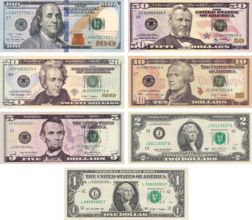
Back Америкатәи адоллар Abkhazian Amerikaanse dollar Afrikaans US-Dollar ALS የአሜሪካ ዶላር Amharic Dólar estausunidense AN Geandra Rica daler ANG دولار أمريكي Arabic دولار ميريكاني ARY دولار امريكانى ARZ আমেৰিকান ডলাৰ Assamese
 Federal Reserve Notes (obverse) | |
| ISO 4217 | |
|---|---|
| Code | USD (numeric: 840) |
| Subunit | 0.01 |
| Unit | |
| Symbol | $, US$, U$ |
| Nickname | List
|
| Denominations | |
| Superunit | |
| 10 | Eagle |
| 100 | Union (Proposed, never issued) |
| Subunit | |
| 1⁄10 | Dime |
| 1⁄100 | Cent |
| 1⁄1000 | Mill |
| Symbol | |
| Cent | ¢ |
| Mill | ₥ |
| Banknotes | |
| Freq. used | $1, $5, $10, $20, $50, $100 |
| Rarely used | $2 (still printed); $500, $1,000, $5,000, $10,000 (discontinued, but still legal tender); $100,000 (discontinued, not legal tender, and only used for specific purposes) |
| Coins | |
| Freq. used | 1¢, 5¢, 10¢, 25¢ |
| Rarely used | 50¢, $1 (still minted); 1⁄2¢, 2¢, 3¢, 20¢, $2.50, $3, $5, $10, $20 (discontinued, but still legal tender); $25, $50, $100 (not intended for circulation). |
| Demographics | |
| Date of introduction | April 2, 1792[1] |
| Replaced | Continental currency Various foreign currencies, including: Pound sterling Spanish dollar |
| User(s) | see § Formal users (11), § Informal users (7) |
| Issuance | |
| Central bank | Federal Reserve |
| Website | federalreserve.gov |
| Printer | Bureau of Engraving and Printing |
| Website | bep.gov |
| Mint | United States Mint |
| Website | usmint.gov |
| Valuation | |
| Inflation | 2.7% or 2.4% |
| Source | BLS (November 2024) or BEA (November 2024) |
| Method | CPI or PCE |
| Pegged by | see § Pegged currencies |
The United States dollar (symbol: $; currency code: USD; also abbreviated US$ to distinguish it from other dollar-denominated currencies; referred to as the dollar, U.S. dollar, American dollar, or colloquially buck) is the official currency of the United States and several other countries. The Coinage Act of 1792 introduced the U.S. dollar at par with the Spanish silver dollar, divided it into 100 cents, and authorized the minting of coins denominated in dollars and cents. U.S. banknotes are issued in the form of Federal Reserve Notes, popularly called greenbacks due to their predominantly green color.
The U.S. dollar was originally defined under a bimetallic standard of 371.25 grains (24.057 g) (0.7734375 troy ounces) fine silver or, from 1834,[2] 23.22 grains (1.505 g) fine gold, or $20.67 per troy ounce. The Gold Standard Act of 1900 linked the dollar solely to gold. From 1934, its equivalence to gold was revised to $35 per troy ounce. In 1971 all links to gold were repealed.[3] The U.S. dollar became an important international reserve currency after the First World War, and displaced the pound sterling as the world's primary reserve currency by the Bretton Woods Agreement towards the end of the Second World War. The dollar is the most widely used currency in international transactions,[4] and a free-floating currency. It is also the official currency in several countries and the de facto currency in many others,[5][6] with Federal Reserve Notes (and, in a few cases, U.S. coins) used in circulation.
The monetary policy of the United States is conducted by the Federal Reserve System, which acts as the nation's central bank. As of February 10, 2021, currency in circulation amounted to US$2.10 trillion, $2.05 trillion of which is in Federal Reserve Notes (the remaining $50 billion is in the form of coins and older-style United States Notes).[7] As of September 20, 2023, the Federal Reserve estimated that the total amount of currency in circulation was approximately US$2.33 trillion.[8]
- ^ "Coinage Act of 1792" (PDF). United States Congress. Archived from the original (PDF) on April 7, 2004. Retrieved April 2, 2008.
- ^ "A Constitutional Dollar". Mises.org. March 10, 2010.
- ^ "Nixon Ends Convertibility of US Dollars to Gold and Announces Wage/Price Controls". Federal Reserve Bank of Richmond. Archived from the original on November 20, 2020. Retrieved October 17, 2018.
- ^ "The Implementation of Monetary Policy – The Federal Reserve in the International Sphere" (PDF). Archived (PDF) from the original on April 27, 2017. Retrieved October 17, 2018.
- ^ Cohen, Benjamin J. 2006. The Future of Money, Princeton University Press. ISBN 0-691-11666-0.
- ^ Agar, Charles. 2006. Vietnam, (Frommer's). ISBN 0-471-79816-9. p. 17: "the dollar is the de facto currency in Cambodia."
- ^ "How much U.S. currency is in circulation?". Federal Reserve. Archived from the original on November 13, 2021. Retrieved February 27, 2021.
- ^ "Federal Reserve Balance Sheet: Factors Affecting Reserve Balances - H.4.1". September 21, 2023. Archived from the original on October 4, 2023.